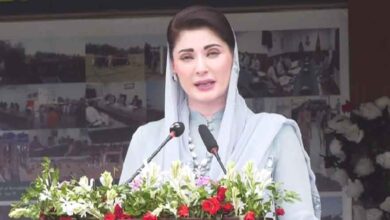ISLAMABAD: The National Disaster Management Authority (NDMA) has issued a warning about potential threats across various parts of the country due to monsoon rains, effective until July 25.
According to the spokesperson, heavy rains in northern regions could trigger landslides and Glacial Lake Outburst Floods (GLOF). The affected areas include Reshun, Brep, Booni, Sardar Gol, Thulo, Hunarchi, Darkut, and Ishkoman.
NDMA also warned of significant increases in water flow in the Indus, Chenab, Jhelum, and Kabul rivers. Low to moderate-level flooding is expected at Marala, Khanki, and Qadirabad on the Chenab River.
Increased water flow is also anticipated at Mangla on the Jhelum River and at Nowshera on the Kabul River. The Indus River may see rising water levels at Tarbela, Kalabagh, Chashma, Taunsa, and Guddu barrages.
In Khyber Pakhtunkhwa, there is a risk of flooding in the Swat and Panjkora rivers and other streams. In Gilgit-Baltistan, rivers such as Hunza and Shigar, along with smaller streams, may also experience flooding.
There is also a threat of flash floods in areas like Shimshal, Hushe, Saltoro, and surrounding regions. In Balochistan, streams in Zhob, Sherani, Sibi, and Musakhel may swell due to heavy rain.
NDMA has reported that landslides have already blocked both sides of the Karakoram Highway and Babusar Top. The spokesperson has urged tourists to avoid traveling to mountainous areas until July 25.
Monsoon death roll reaches 242
At least 11 more fatalities were reported on Tuesday due to intense monsoon rains in Khyber Pakhtunkhwa (KP) and Gilgit-Baltistan (GB), pushing the nationwide death toll to 242 since late June, according to figures from the National Disaster Management Authority (NDMA).
Flash floods, triggered by the downpours, swept through several areas in KP and GB, damaging homes and raising water levels in streams and rivers. In response, Prime Minister Shehbaz Sharif has directed the NDMA to work closely with provincial authorities to provide swift relief to the affected population.
According to the Provincial Disaster Management Authority (PDMA), Swat reported six casualties—including four children—while Bajaur recorded two deaths. One fatality each was reported in Buner and Upper Kohistan.
In Swat, two children were swept away in Sur Dheri nullah, while three others lost their lives when a roof collapsed in Madyan. A woman was also killed by floodwaters in Khawazkhela. Meanwhile, two men in Bajaur’s Loe Mamond and a woman in Upper Kohistan were carried away by floods. A man also died in Buner.
In GB, flash floods continued to wreak havoc, with Rescue 1122 reporting that Danyor nullah had overflowed, flooding homes, destroying crops, damaging irrigation systems, and cutting off access by washing away link roads and suspension bridges.
A severe flood in Thor Nala, Chilas, inundated the Wapda Colony, prompting residents to evacuate. In Astore’s Bolan area, a woman lost her life due to the flooding.
Meanwhile, around 250 tourists stranded on Babusar Highway were successfully rescued by the Diamer administration, volunteers, police, Rescue 1122, and army personnel, according to GB government spokesperson Faizullah Faraq. Reports indicate that 10 to 15 individuals are still missing, with search efforts ongoing.
Rising monsoon toll
Since the onset of the monsoon season in late June, the country has suffered extensive damage. NDMA reports confirm 242 deaths and 596 injuries, alongside the destruction of 826 houses and the loss of 203 livestock.
Among the dead, 79 were men, 42 women, and 113 children. Punjab remains the worst-hit, with 135 fatalities. KP has reported 56 deaths, Sindh 24, and Balochistan 16. Two deaths were confirmed in Azad Jammu and Kashmir, and one child died in Islamabad. So far, no official deaths have been recorded in GB by the NDMA.
Flood alerts and GLOF warnings
Floodwaters have submerged homes and fields across Punjab, particularly in low-lying areas near rivers such as Ravi, Sutlej, Chenab, and Indus. Mass evacuations have taken place in Muzaffargarh, Dera Ghazi Khan, and Rahim Yar Khan due to the threat.
In Jhang, rising levels in the Jhelum River have flooded over 20 villages. A low-level flood is also reported in Sutlej River at Sulemanki, and concerns persist over possible water discharges from Indian dams on the Beas and Sutlej rivers.
The Pakistan Meteorological Department (PMD) has issued fresh alerts for glacial lake outburst floods (GLOFs) in GB and KP, particularly affecting areas like Upper and Lower Chitral, Upper Dir, Swat, and Upper Kohistan.
According to a PMD advisory, the ongoing weather pattern is expected to persist through the week, raising the threat of flash floods, GLOFs, and landslides in vulnerable northern regions. The NDMA has urged all relevant authorities—including PDMAs, local governments, the military, and humanitarian agencies—to be prepared for potential emergencies.
Forecasts suggest scattered rainfall in Gilgit, Skardu, Hunza, Astore, Diamer, Ghanche, Muzaffarabad, Neelum Valley, Bagh, Haveli, and Poonch. Similar weather is anticipated in Chitral, Dir, Kohistan, and nearby mountainous regions.
There is a heightened risk of landslides, mudslides, and rockfalls in areas such as Kolai Palas, Lower and Upper Kohistan, Tatta Pani, Jaglot, Nagar, Rondu, Hunza, Skardu, and Chitral.
Lahore rain situation
Heavy monsoon rain lashed Lahore and its adjacent areas in the wee hours on Wednesday, causing urban flooding in the provincial metropolis. Majority of the city localities submerged under the rainwater.
The heavy rain paralysed the routine life in the city and the low-lying areas, main highways and underpasses were submerged in the rainwater. Due to the stagnant rainwater, the vehicles and motorcycles were blocked on the roads.
Heavy monsoon rainfall broke records in various areas of Lahore, with multiple locations receiving over 100 millimeters.
The highest rainfall was recorded in Tajpura with 110 mm, followed by 109 mm at the airport. Jail Road received 70 mm, Gulberg 59 mm, Lakshmi Chowk 94 mm, Upper Mall 97 mm, and Mughalpura 88 mm. Other areas included Nishtar Town with 71 mm, Chowk Nakhauda 98 mm, Pani Wala Talab 99 mm, Farrukhabad 86 mm, Gulshan Ravi 77 mm, Iqbal Town 61 mm, Samanabad 74 mm, Johar Town 35 mm, and Qurtaba Chowk 71 mm. The average rainfall recorded across Lahore was 81.1 mm.
Karachi weather
Clouds hovered over Karachi on Wednesday as light drizzle was reported early morning in several areas, including Lyari, Mauripur Road, Clifton, and Baldia.
Drizzle was also recorded in Sohrab Goth, Abbas Town, Gulshan-e-Iqbal, Gulistan-e-Johar, and University Road, as well as on Shahrah-e-Faisal, Drigh Road, Malir, Saddar, MA Jinnah Road, and Tariq Road. The minimum temperature recorded was 29°C, with humidity at 68%. Light rain and drizzle are expected to continue in the morning and at night for the next two days. The weather is likely to remain mostly cloudy and humid throughout the day. Currently, the temperature stands at 30°C, with sea breeze blowing from the southwest at 16 km/h. The maximum temperature today is expected to reach up to 35°C.
Balochistan weather update
Most parts of Balochistan are experiencing hot and humid weather, while rain is likely in districts including Kohlu, Musakhel, Loralai, Zhob, Kalat, Ziarat, Khuzdar, and Harnai. According to the Meteorological Department, Quetta recorded a maximum temperature of 39°C, Kalat 33°C, Sibi 42°C, Nokundi 46°C, and Turbat 39°C. In the coastal regions, Jiwani and Gwadar reported a high of 33°C.







